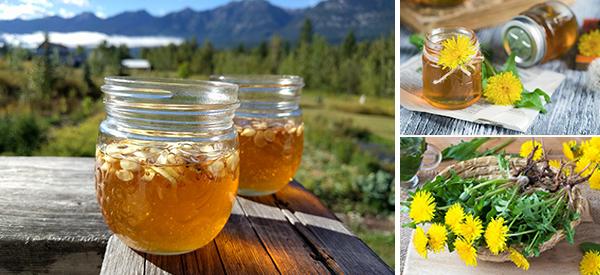
Dandelion Root Infused Honey for Immunity
As with all parts of your mind and body, the incredible immune system becomes even more important as you age.
You can help your immune system out by impeding potential disease-causing pathogens by increasing your intake of immune-boosting foods such as dandelion root infused honey.
Dandelion and honey are a match made in heaven. From a culinary standpoint, the bitterness of dandelion is complemented by the sweetness of honey.
Dandelion
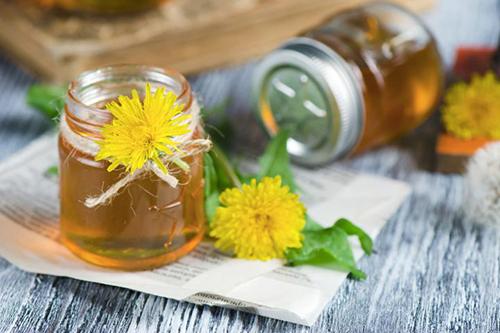
Studies of dandelion extract and dandelion root extract have shown antimicrobial activity and strong antiviral compounds with evidence for use even against strains of HIV. In addition to these immune-supportive attributes, the dandelion root contains many vitamins, minerals, fatty acids, mucilage, pectin, as well as carbohydrates and carotenoids. The carbohydrate component is in the form of inulin which is a known immune booster for the digestive tract and as such, is deemed supportive against potential cancers of the digestive tract.
Honey is best used raw, unpasteurized, uncooked, and local where available. There are many immune-boosting properties in honey, including its antimicrobial properties in addition to honey’s extensive therapeutic attributes. Honey provides protection for your cells from damage by free radicals, due to compounds in honey called polyphenols and acts as an antioxidant. Also, honey is nutritious, full of vitamins and minerals, and is a natural antibacterial and antifungal.
Harvesting Or Sourcing Dandelion Root
Dandelions grow almost all over the world and you may be able to wild source these from any sunny disturbed area that is clean and clear of toxic chemicals and herbicides. It’s a great idea to get a foraging book to reference.
There are also options to purchase dandelion root, often dried and available at health food stores or online.
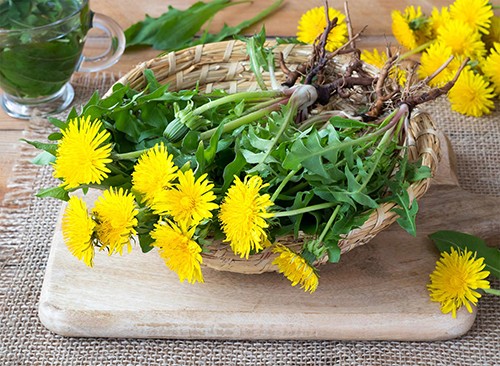
Dandelions can live for up to 13 years and their long taproots can grow up to 15 feet deep, bringing up hard to reach nutrients from the subsoil. Normally, dandelions grow 10 to 15 inches deep and can reproduce new plants from just a small portion of less than ½ an inch of root. Some research suggests harvesting dandelion roots in the early spring or late fall when most of the plants’ energy is stored in the root. I have chosen to harvest young dandelions in early fall after they have finished flowering.
Preparing Dandelion Root for Infusion
There are many ways to use dandelion root, but for this recipe, I will be using young, fresh, raw roots. However, to make a more shelf-stable infusion, you would need to choose dry or roasted roots. A honey infusion with higher water content, like the recipes to follow, is not shelf-stable, and as such requires refrigeration or at least a cold room and should be consumed within 30 days.
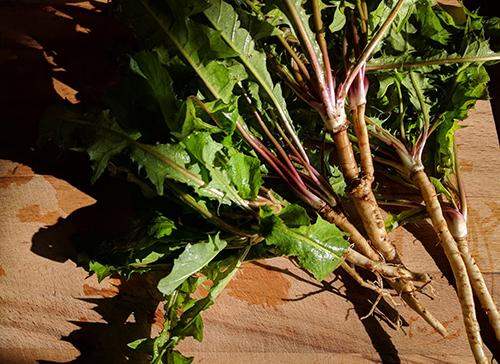
As they are not shelf-stable, you must use your best judgment and check for any signs of spoilage. For the following recipes, I harvested dandelion root first thing in the morning, cleaned, sliced, a placed in honey immediately so that all the beneficial attributes of the dandelion root would be encased and infused in honey. Another option would be to dry and ground dandelion root and use it as a powder to mix into the honey infusion.
Honey Infused with Dandelion Root, Ginger, and Garlic
For this recipe, I used fresh, straight from the garden, young dandelion roots, and fresh chopped ginger and garlic due to their many healthful benefits including their immune-boosting properties as well as their complementary flavor to honey.
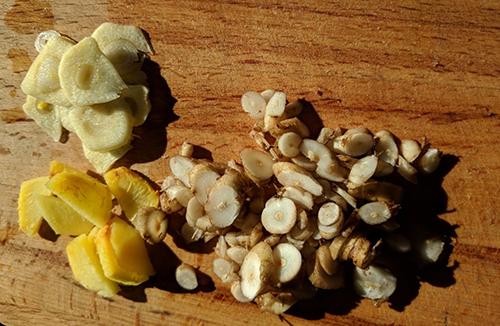
Recipe:
- ½ cup raw, unpasteurized, local honey
- 1 teaspoon dry or 1 tablespoon fresh dandelion root
- 1 teaspoon dry or 1 tablespoon fresh ginger
- 1 teaspoon dry or 1 tablespoon fresh garlic
- Place ingredients in the bottom of a sterilized jar and pour honey in to fill the jar.
- Close with a tight-fitting lid. Keep in a cool dark place, allowing it to rest for 1 to 4 weeks.
The longer the infusion rests, the stronger the concoction will be. Check your creation periodically. You may notice the ingredients have floated to the top so you may want to stir the mixture and take a taste while you’re at it.

Honey Infused with Dandelion Root, Oil of Oregano, Rosemary Essential Oil, And Thyme Essential Oil
This recipe is just too easy, infusing the honey with fresh, young dandelion root and food-grade essential oils. Infusing honey with essential oils is a clean and convenient option, but you may of course use fresh or dried herbs instead. The immune-boosting properties and antimicrobial activity of oregano, rosemary, and thyme are the reasons I chose these oils in addition to their spicy, complimentary aromas.
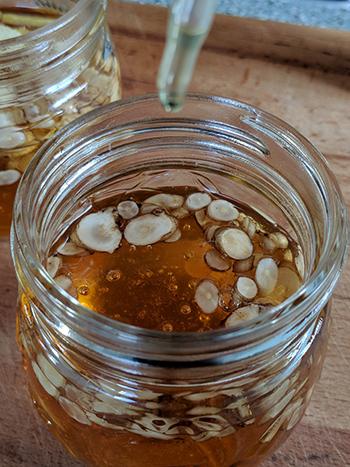
Recipe:
- ½ cup raw, unpasteurized, local honey
- 1 teaspoon dry or 1 tablespoon fresh dandelion root
- 5 drops of oil of oregano or 1 teaspoon dry or 1 tablespoon fresh oregano
- 5 drops of rosemary essential oil or 1 teaspoon dry or 1 tablespoon fresh rosemary
- 5 drops of thyme essential oil or 1 teaspoon dry or 1 tablespoon fresh thyme
- Place the dandelion root in the bottom of a sterilized jar and pour honey in to fill the jar.
- Using a dropper, drop essential oils on top of the honey.
- Close with a tight-fitting lid and keep in a cool dark place, allowing it to rest for 1 to 4 weeks.
How to Use It:
The longer the infusion rests, the stronger the concoction will be. Check your creations periodically, stirring if necessary, and maybe a taste test.
Each of these recipes has a multitude of flexibility. Dandelion roots tend to be very bitter so using honey helps to balance the bitterness. You might want to choose other complimentary flavors such as cinnamon and clove or citrus flavors to brighten the infusions.
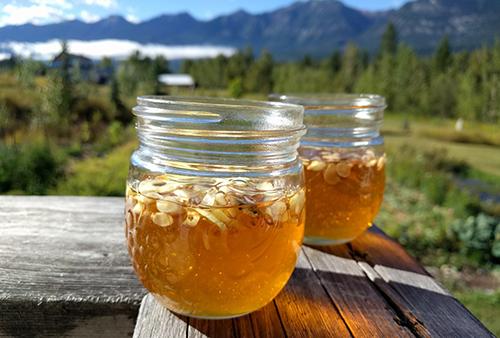
For immunity, take a teaspoon of this concoction daily. Another simple way to use this honey is to use a teaspoon melted in a tablespoon or two of apple cider vinegar as a compliment to your favorite salad dressing.
As with any new plant or product, there is always the potential for an adverse reaction such as stomach upset or allergy. Always listen to your body and remember it is best to start slowly when using any new plant by smelling it and touching it to your skin.
In addition, it is good to note that it is recommended to keep your honey intake to a maximum of 6 teaspoons daily due to the sugar content.
You may also like:
 How to Make Dandelion Bread (With Pictures)
How to Make Dandelion Bread (With Pictures)
No-Grid Survival Projects: How to Produce Everything You Need on Your Property (Video)
10 Natural Remedies You Can Only Make This Fall
6 Beneficial Weeds You Shouldn’t Have Pulled Out from your Garden!

I have made dandelion flower infused coconut oil for use as a skin salve/conditioner. I could use this internally in recipes too, yes? What would the benefits be? What recommendations would you make?
Hi Irene,
Thank you for your comment.
Dandelion flower infused coconut oil sounds great 🙂
There is a growing body of evidence that coconut oil offers some health benefits, both internally and externally.
Always be cautious when consuming infused oils. Onset time can vary vastly from one person to the next, taking anywhere from 30 minutes to 2.5 hours to feel effects. It is always better to start conservatively, testing to see how strong your batch turned out.
God bless!
I have made and drank Dandelion tea sweetented with honey before, delicious!
Until we are able to grow these items and have them available, is there a source we can go to now?
I see them on Esty! I think I will add some dried root I have saved to an elderberry, rosehips, clove raw local honey. Thanks this is a great article.
Hello!
I love your easy to follow articles!!! Thank you so much for making these printable and so beautiful. This is my favorite lil website for all things herbs.
Dianne
Hi Dianne,
Thank you so much for your feedback.
We are glad you found this article useful and easy to follow.
God bless!
Sounds interesting, and I actually cultivate my lawn dandelions because my hens *LOVE* the greens! Always wait if bees are feeding. No chemicals. Guess we’ll be sharing now 🙂
I am a Beekeeper in Upper South Carolina. Can I let my girls enjoy the Pollen first and then harvest it? I have a good amount here in February. Thank you for these articles. They are very helpful.
Well as it says, I quote “
Some research suggests harvesting dandelion root in the early spring or late fall when most of the plants’ energy is stored in the root.“ end of quote.
That why I harvested late autumn/early winter.
I think if you harvest some before flowering or winter, it will remain still plenty for the bees and for reproduction.
Than you for this great information.
I harvested a lot of dandelion roots early winter just one day before snow.
Cleaning them was not very easy, but finally was done and immersed in honey in a large 5 litre glass jar. After the first snow melted a bit I achieved to dig out more roots, so I added them after being cleaned to the same batch of honey , so the jar with honey was packed with dandelion roots.
I let it sit for the whole winter, mixing it with a wooden spoon, but later on the honey started to crystallize, so I put the jar in an larger pot with water and wormed up gently just for the honey crystals to melt.
I guess the roots released better their content in warm ( not hot) honey.
Now in spring is ready for consumption, the best time when immune system needs the most.
I love this site! The information is always so helpful. I am a retired nurse and spent the last 18 years before retirement is biomedical research. The more I learned of pharmaceuticals, the less I trusted them. That sent me on my journey to (re-)discovering the power of herbs. I can’t wait to try this recipe. My husband has chronic lung issues, so I’m hoping that this will help him to have a stronger immune system.
try taking mullien as it has super benefits for lungs
There are so many recommendations for different plants and herbs for different and the same health conditions. do you have a way to categorize them from, use this first, to use this last. I feel like I’m getting a lot of information and feel overwhelmed with choices.
Living in Eastern Ontario Canada I pick the roots in early spring before the aerial or stem starts to grow, Then clean and slice lengthwise, steam for a while to congeal, Chop and roast at about 400 degrees for 15 minutes. Dandelion root tea.
This all sounds very interesting to me also, but being a retired nurse also, I have to ask about the unpasteurized honey being stored for long periods with mixed ingredients. Would there be any concern about botulism?
Honey is naturally antibacterial, antimicrobial, antiparasitic, etc. It does not go bad. There aren’t any ingredients in the recipe to cause any concern, either. Just make sure the jar(s) and utensils you use are clean/sterile, and you should be fine. Always remember to use plastic or wooden utensils when touching/measuring/stirring honey – metal will kill all the good properties in honey you are wanting to make use of.
the Dandelions plant is interesting, but I still have doubts how to recognize it! Is it possible to fall on false dandelion plants that look like, or poisonous plants?
Thanks for an answer
Ramdane
Dandelions have no known poisonous look a likes , but do get confused with catsear, hawksbeard, and hawkbit, which all multi-flower heads, with Dandelion being only single flower head.
I just joined this discussion. How do I print the recipes??
directly above review section is print tab